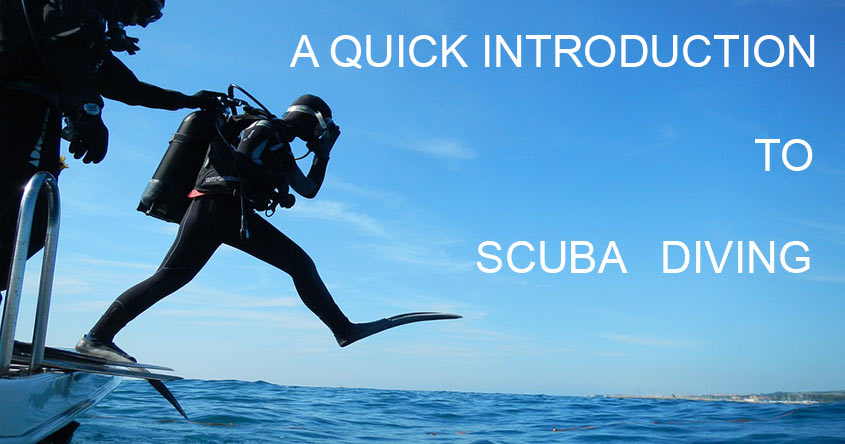
This section explains scuba diving for those people who know nothing, or next to nothing, about but are interested in learning about PADI scuba - and maybe one day having a go themselves. We try to explain everything clearly and in everyday terms, as our experience with more than one PADI dive instructor has shown that they sometimes use technical or specific terms, even when talking to novices. If there's anything that is not explained or is left unclear, (any questions, in fact) then please just let us know, or leave a comment below.
We plan to clearly explain dive equipment, possible problems, what to do and what not to do, and how to best enjoy a scuba dive, while clearing up a few fallacies in the process.
Dive equipment
Scuba diving equipment comes in several parts, and they include breathing apparatus, things to help you sink or float, eye protection, things to help you move around underwater, and something to keep you warm.
Breathing Apparatus - The Air Tank & Pipes
To be able to scuba dive, a diver needs to breathe air while underwater. This is the most important part of the equipment, and is the big difference between scuba diving and other activities, such as snorkeling or skin diving. The breathing apparatus is why scuba is called S.C.U.B.A. (Self-Contained Underwater Breathing Apparatus). It is the only piece of equipment that a diver MUST have, but the other pieces are important, too. Essentially, it is a large aluminium tank that it sealed and contains compressed air, NOT oxygen. Coming out the top of the tank are four pipes; two lead to mouthpieces (one for use and one spare), one leads to a gauge, and the other connects to the dive jacket. The mouthpiece allows air to be breathed in through the mouth, but not the nose. It does not blow air into the diver's mouth, and nor does the diver have to suck very hard. When the diver breathes in, the right amount of air comes freely. When he or she breathes out, the air flows out of the mouthpiece from a special hole with a valve. It's a perfect balance. The gauge shows the diver, or his or her dive instructor, how much air is left in the tank. Next to this gauge there is usually a depth gauge to show how deep the diver is, too. The fourth and final pipe leads to the diver's jacket.
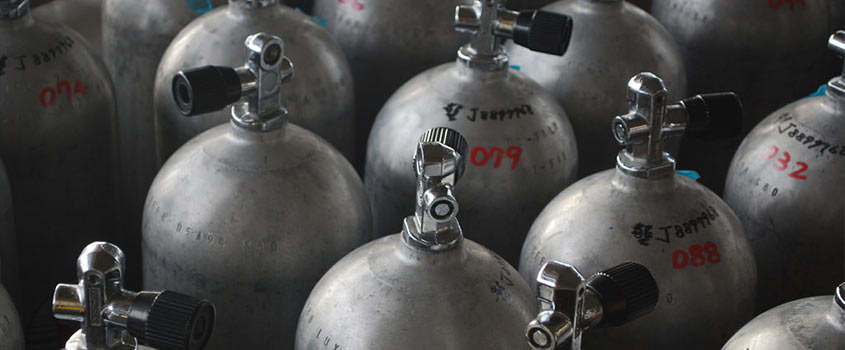
Dive Jacket - Holding the Tank & Helping You to Float
The dive jacket does two main jobs. Firstly, it has straps to attach and hold in place the large and heavy dive tank. This is held on the diver's back in a position should that not hinder head or leg movement. It doesn't have sleeves, and looks just like a waistcoat or vest. This jacket's other job is to contain air and be inflated by as much as the diver chooses. At the beginning and end of each scuba dive it is common to float at the surface of the water, an inflated dive jacket allows the diver to float easily. The fourth pipe from the breathing apparatus enables the diver to easily add as much or as little air as needed at the press of a button. There is also another button on the dive jacket to let the air out, deflating the jacket and causing the diver to sink.
Weightbelts - Helping You to Sink
All of the pipes, the tank and the jacket actually cause divers to float more than sink, which is not the idea of scuba diving. So, how does a diver sink slowly and in a controlled way? Well, they wear a simple belt which has lead weights on it. The amount of weights for new divers is decided by his or her PADI instructor. Fatter divers, and those with very little or no experience tend to need more weights, because they are usually buoyant, which means they float easily. Thinner and relaxed divers tend to sink easily, and therefore needs less lead weight on their belts. Some experts can dive with just one (1kg.) weight, whereas large people may need as many as 8 or more. There is no shame in needing more weights.
Being Able to See Underwater
The whole reason for recreational scuba diving is to see the fish and other animals, reef, rocks or a shipwreck. Scuba divers' eyes are no different from anyone else's, and therefore need cover or protection in order to focus underwater. Regular two-lens swimming goggles are no good for scuba diving, mainly because they do not cover the diver's nose and also because two the air spaces would be subject to the increased pressure at deep depths. Scuba divers wear a one-piece 'mask' that offers comfort, good visibility, and prevents water from going up the diver's nose.

Moving Around in the Water
scuba-diving-finsScuba diving is not swimming, and thus requires little or no arm movement. To move around in the water from one location to another, scuba divers wear fins (not flippers) on their feet. They are usually rubber or plastic and fit comfortably on either foot (no right and left). For novice and lower level divers, fins are usually one-piece items which slip on and off. More advanced and professional divers usually buy and wear their own personal diving fins which are made up of ankle-length boots and large fins which go over them. 'Finning' along the dive site is simply done by moving one's legs, like on an exercise machine.
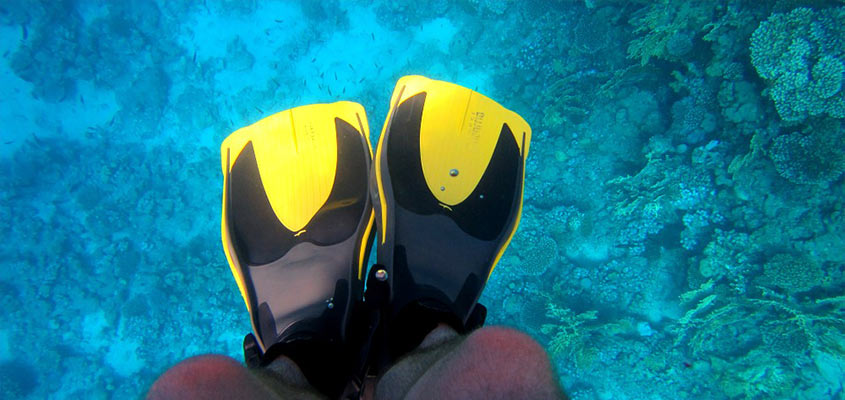
Staying warm
Finally, scuba divers usually remain submerged in sea or river water for up to an hour, without exerting too much energy. Even in tropical waters, such as Thailand, the water is cooler than one's body temperature. Most scuba divers wear a wetsuit, which does not keep them dry, but does help them to stay warm. Wetsuits do this by trapping a thin layer of water in between the diver's skin and the wetsuit itself. The diver's body temperature warms this water and it stays there, keeping them warm enough. Wetsuits can have long or short legs and sleeves, and vary in thickness. Beginner divers usually wear short-sleeve and short-leg wetsuits. This is because they are easy to get into and out of, and new divers tend to spend less time in the water than experienced divers due to using their air quicker, and keep themselves warm by moving around excitedly during the dive.
| In the dive industry the following names are used instead of the layman's terms in this article. | |
|---|---|
| Fins | flippers |
| Mask | goggles |
| BCD (buoyancy control device) | dive jacket |
| Regulator (reg.) | first-choice mouth piece |
| Octopus | second-choice/spare mouthpiece |
| First stage | junction of pipes/hoses |
| Second stage | gauges |
| Descend | go to deeper water |
| Ascend | go to shallower water |
| Buoyancy | ability to float |
All of the diver's equipment should be in good working condition, especially the air tank and its pipes and gauges. Leaks can occur, but very small leaks - producing small bubbles - are nothing to worry about.
Novice divers will have their equipment assembled by their qualified PADI scuba dive instructor, and needn't worry about it. Those students taking their PADI Open Water Diver course will learn how to correctly assemble the equipment, and check their peers' (dive buddies').
Straps should be tight but comfortable and the weightbelt should be accessible for immediate removal in an emergency. The gauges need to be accessible for checking, but tucked out of the way to prevent them getting tangled or causing damage from banging onto rocks or the reef.
A common mistake by novice divers is to wear the mask too tightly, needlessly worrying that water will get in. In fact, a mask can be very loose, as the water pressure at depth will make a perfect seal. Wearing one's mask too tight will cause pain, and other possible problems.
Most scuba divers on their first ever scuba dive are lucky enough to have their dive instructor adjust and control their buoyancy for them during the dive.
However, any diver deflating his or her dive jacket in order to sink a little needs to be aware that the air in the jacket can only escape if the air escape hole is the part nearest to the water's surface. Novice divers are often seen trying to get air out by pressing the correct button, but the release pipe is not pointing up towards the surface, hence no air can escape.
What You Need To Do When You Dive
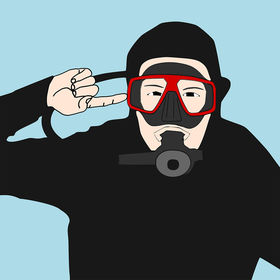 There is one rather important thing that all divers must do, and cannot be done for them by any helper, and that is to equalize their ears. Without wanting to go into confusing details, the deeper any diver or snorkeler goes, the more their ears will feel pressure. It's just like when flying in a plane, but more so. This happens to all divers, regardless of their experience or ability. All the pain is, is trapped air feeling the pressure deep water exerts. A scuba diver simply needs to breathe in, hold his or her nose, then close their mouth and try to breathe out. The pressure and any pain will be instantly relieved by air exiting from the ear canal. It may sound a lot more complicated than it is, but it's very simple. This 'equalizing' needs to be done whenever pressure is felt in the ears, and is generally every two or three metres in depth. Divers only need to equalize when going deeper. They do not need to do so when just diving at a steady depth or going up to shallower water. There isn't really anything else that the novice scuba diver needs to actually do while diving. As long as they relax, and know the whereabouts of their scuba instructor or dive buddy, everything else will take care of itself.
There is one rather important thing that all divers must do, and cannot be done for them by any helper, and that is to equalize their ears. Without wanting to go into confusing details, the deeper any diver or snorkeler goes, the more their ears will feel pressure. It's just like when flying in a plane, but more so. This happens to all divers, regardless of their experience or ability. All the pain is, is trapped air feeling the pressure deep water exerts. A scuba diver simply needs to breathe in, hold his or her nose, then close their mouth and try to breathe out. The pressure and any pain will be instantly relieved by air exiting from the ear canal. It may sound a lot more complicated than it is, but it's very simple. This 'equalizing' needs to be done whenever pressure is felt in the ears, and is generally every two or three metres in depth. Divers only need to equalize when going deeper. They do not need to do so when just diving at a steady depth or going up to shallower water. There isn't really anything else that the novice scuba diver needs to actually do while diving. As long as they relax, and know the whereabouts of their scuba instructor or dive buddy, everything else will take care of itself.
The Things That You Should NOT Do While Underwater
Novice scuba divers can't really do too much wrong, simply because their qualified and experienced PADI dive instructor will be watching them at all times. PADI, the international organization which regulates scuba diving, restricts the number of novice divers per dive instructor to just a few, hence ensuring he or she can carefully monitor them both/all with everyone's safety and enjoyment in mind. There are just two things that any diver should NOT do, and this needs to be made clear to new scuba divers.
Do not touch anything underwater with your hands.
Do not hold your breath.
Touching rocks and coral should not normally pose a problem, but novice divers can very easily mistake a poisonous sea creature for rock or coral. If you don't touch anything, you can't get hurt. It's as simple as that.
Holding your breath may sound like a good idea to conserve your air supply, but it is in fact very dangerous. This is because any diver who breathes in, holds his or her breath and then goes up to shallower water will put unnatural and dangerous pressure in their lungs. Just breathe in and out naturally and at your normal speed and your dive will be safe and enjoyable. Anyone thinking that holding their breath will make their dive longer is wrong. Your dive instructor will manage your dive depth and water position to make the dive as long as possible. Your job is to breathe normally, look, don't touch, and enjoy the dive.
How Can My Instructor Maximize My Dive Time?
Quite simply, scientific facts state that diving deeper reduces any diver's (not just a novice's) air supply more quickly than diving in shallow water. There are no tricks to beat the system; it's a fact. Every PADI scuba dive instructor will do his or her best to manage the 'dive profile' (how deep and for how long) to ensure that his or her divers can stay underwater for as long as possible, or as long as they want. This is done by the dive instructor monitoring the diver's air supply and diving ability. Those who use more air than others will be taken to shallower (clearer and more colourful) water instead of kept deep and having to finish early. 45 minute dives are possible for novices, but they need to relax and be honest with their instructor. Holding breath or lying about the remaining air is only going to hinder, rather than help, the situation. To make things worse, those kinds of people who may feel a little macho and proud of how good they are - or embarrassed about not being as good as others - are the most likely to use their air more quickly. It's another unavoidable fact that large men consume more air than slim ladies.
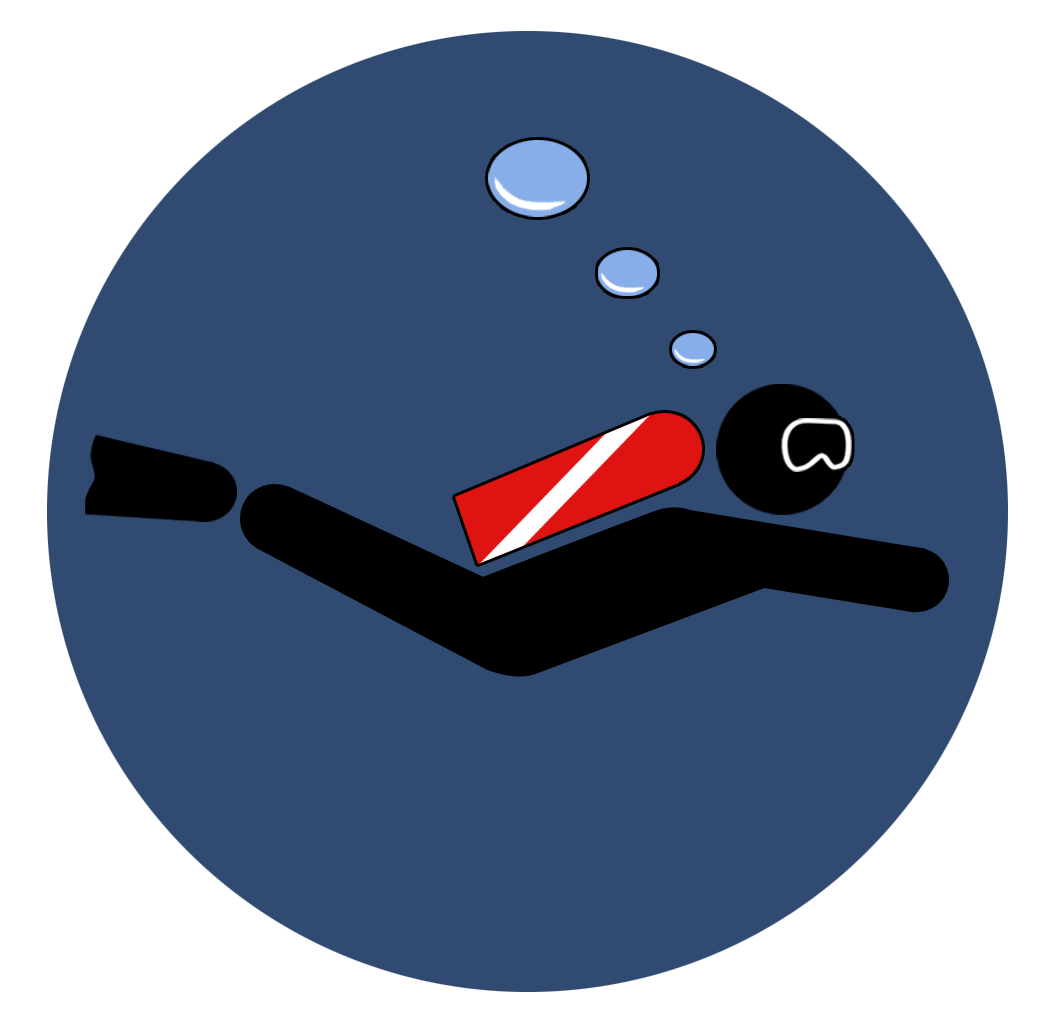
 Like
Quote
Like
Quote
